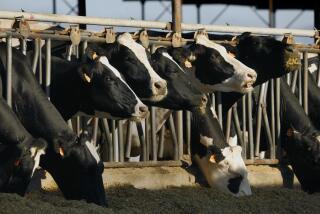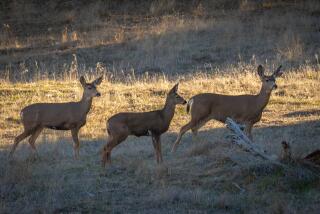Brain Disease Threatens Elk-Ranching Industry
FORT COLLINS, Colo. — Ric and Myrna Hansen became elk ranchers three years ago so they could raise animals without having to kill them.
So it wasn’t a hard decision to turn down a recent buyout offer from the U.S. Agriculture Department. To accept would have been to condemn their 700-head herd to slaughter as officials try to stop a deadly deer and elk disease.
The Hansens, who raise elk as breeding stock, concede that their decision is risky. The offer was a one-time deal, and they could be left without a way to recoup a $400,000-plus investment because their ranch east of Fort Collins is in Colorado’s ground zero for chronic wasting disease.
“It’s a big gamble,” said Ric Hansen as he walked into a corral full of bull elk, all warily eyeing the strangers with him.
“We’re really attached to all of them,” said Myrna Hansen, rubbing the head of Theo, a young bull the family raised from a calf. “But we can’t just have them as pets forever.”
The Hansens and another rancher are the only ones of about 20 in the disease endemic area who refused the government buyout. It was offered after a case of chronic wasting disease at an elk ranch raised fears of an epidemic because the rancher had shipped animals to other ranches in the state.
Despite the devastation, the industry will persevere, predicted Ron Walker, president of the Colorado and national elk breeders’ associations.
He believes the attention and push for federal research funding will lead to a live test for elk so they don’t have to be killed to determine if they are infected.
“It’s a bad thing that could be good,” Walker said.
For decades, the disease has been found in wild deer and elk herds in northeastern Colorado and southeastern Wyoming. As the illness eats holes in the animal’s brain, the creature becomes emaciated and dies.
There’s a live test for some deer, but it’s time-consuming and difficult.
About 2,900 captive elk have been killed to try to stem the disease. Some were from ranches in the endemic area, where experts fear wildlife and captive elk can infect each other.
Colorado’s elk industry generates $30 million a year through the sale of antlers, meat and breeding stock, and ranch hunting. It is the second-largest elk industry in the country, behind Minnesota’s. There were about 160 licensed elk ranches at the start of the year.
The Hansens, whose ranch is disease-free, can sell antlers for natural-food supplements but cannot sell breeding stock because of a mandatory 60-month surveillance period for elk herds.
The family can hold on for a while because Ric Hansen’s real estate business provides most of their income.
But they and other ranchers believe they have been blamed unfairly for the outbreak. They point to Colorado Division of Wildlife reports saying biologists first noticed the disease in deer in state research facilities in 1967 and in Wyoming research facilities in the 1970s.
“You can’t tell us we started it,” said Walker, who raises elk near Penrose in south-central Colorado.
Critics of elk ranching lament this spring’s revelation of the first cases in the wild west of the Continental Divide. Two deer inadvertently penned inside an elk ranch near Craig were infected.
Wildlife advocates fear the impact on the state’s multimillion-dollar big-game hunting industry.
Wyoming banned game ranches 30 years ago because of concerns about diseases and the impact on wildlife. Montana voters approved a ban in 2000 for some of the same reasons.
John Mumma, a retired state wildlife chief, said elk ranches might be breeding grounds and conduits for chronic wasting disease and other illnesses as animals congregate and get moved around.
He fears captive herds are endangering Colorado’s wildlife. “I think this a threat that goes beyond our imagining right now.”
Since the 1980s, the illness has been found in free-roaming elk and deer in northeastern Colorado and southeastern Wyoming. It was the only place it was found in the wild until this year’s outbreak among deer in Wisconsin.
Walker and other ranchers fear wild animals are infecting captive animals. He also is concerned about the impact of negative publicity on the industry, which has been fed by the disease’s link to mad cow disease.
Chronic wasting disease is in the same family as bovine spongiform encephalopathy, or mad-cow disease.
Mike Miller, wildlife division veterinarian, said the strain of misfolded protein, or prion, that appears to cause wasting disease is quite different from the one that causes mad cow disease.
There is no evidence that chronic wasting disease can be transmitted to cattle or people, although scientists cannot rule it out.
Experts insist no one can say who is to blame for the spread of the disease.
“It’s trying to re-create history that can’t reliably be reconstructed,” Miller said. “It’s all so intertwined.”
The disease has now been discovered in wild or captive deer and elk in Colorado, Wisconsin, Wyoming, Kansas, Nebraska, Montana, Oklahoma and South Dakota and two Canadian provinces.
In Wisconsin, game ranches don’t appear to factor in the outbreak, Miller said. In southwest South Dakota and northwest Nebraska, game ranches are believed to be the source of chronic wasting disease recently found in the wild.
State Agriculture Commissioner Don Ament fears the worst for elk ranching.
“The hysteria that’s out there, ranchers can’t sell anything, can’t sell meat,” Ament said. “How are we going to keep these guys in business?”
More to Read
Sign up for Essential California
The most important California stories and recommendations in your inbox every morning.
You may occasionally receive promotional content from the Los Angeles Times.










